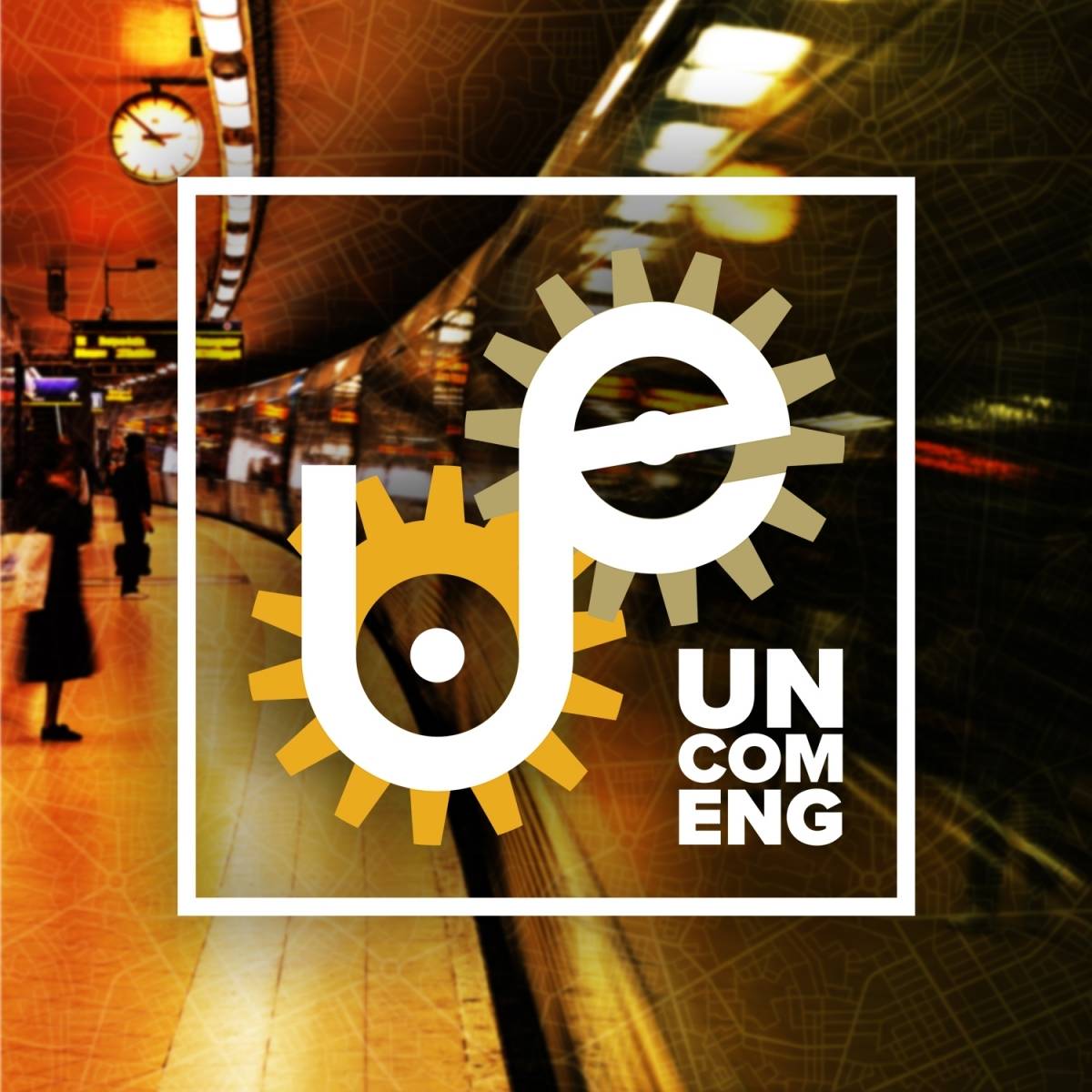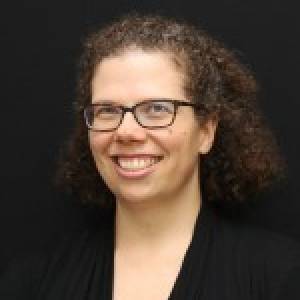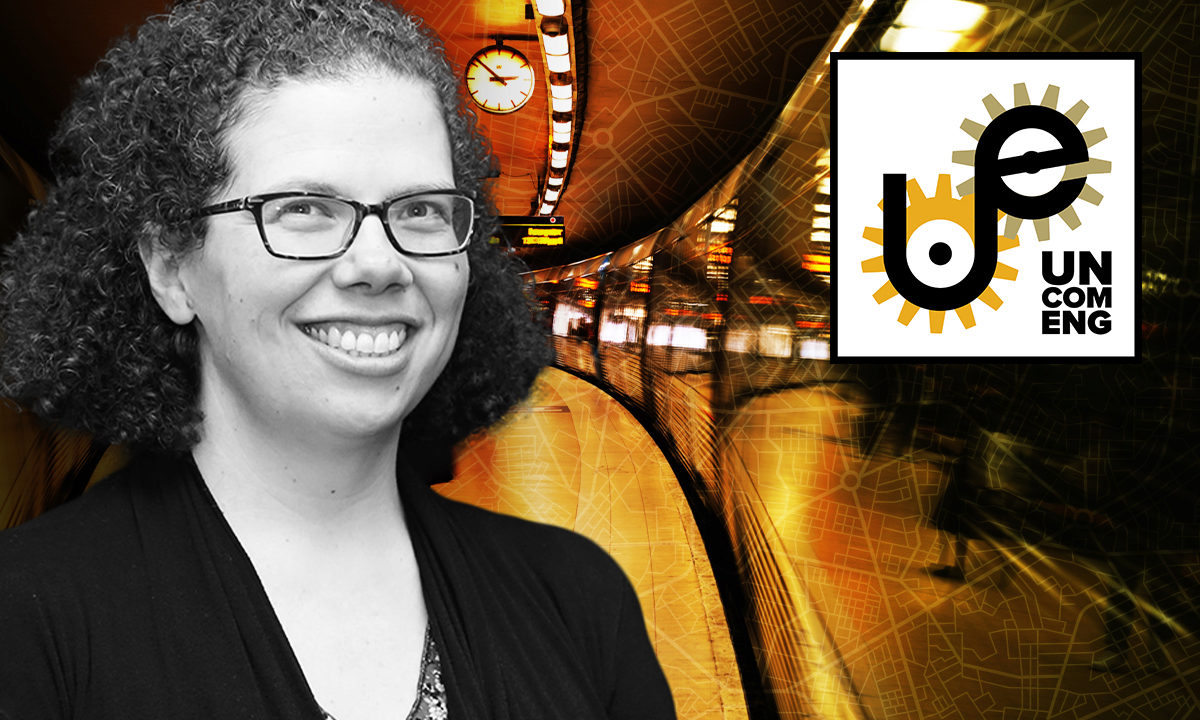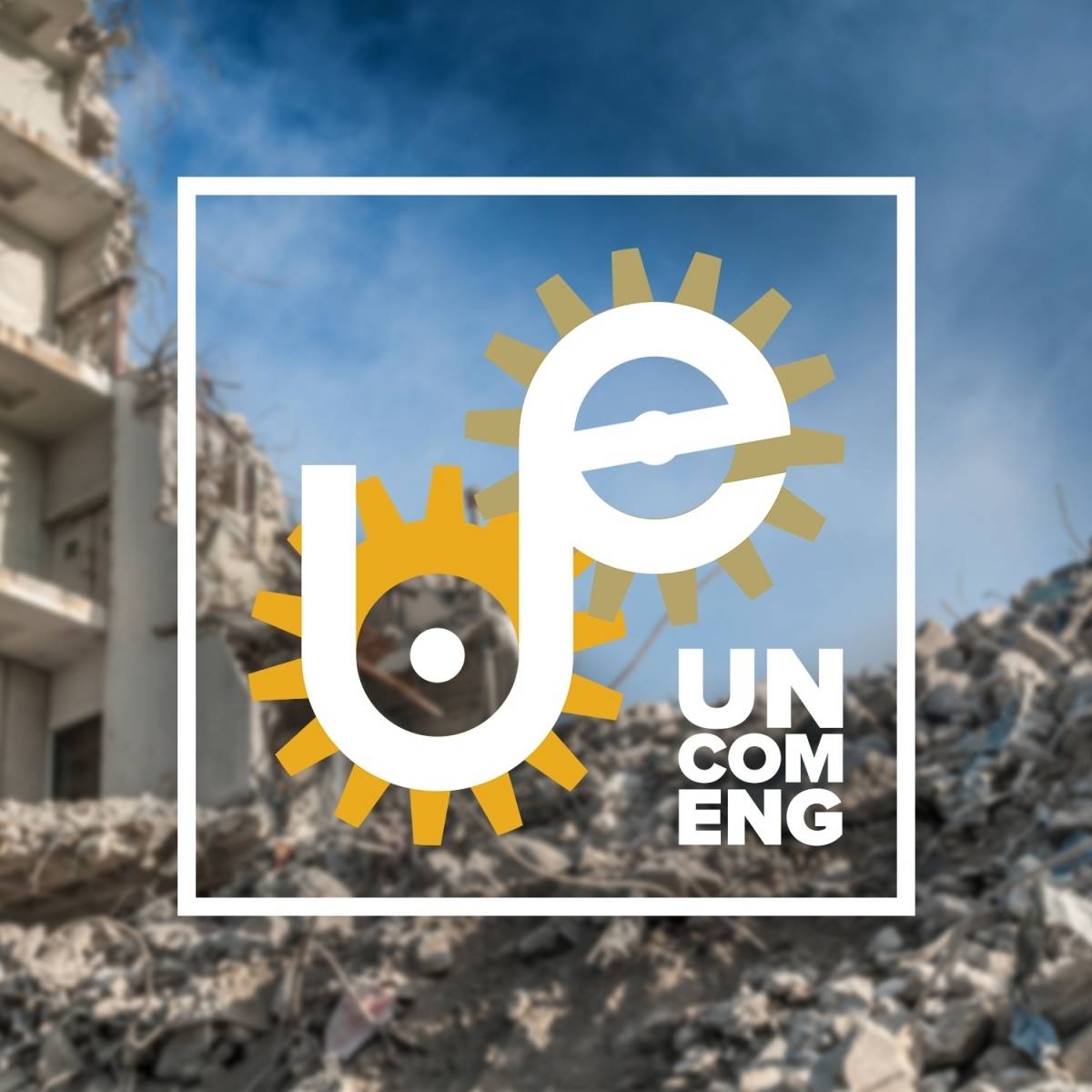
Steve W. McLaughlin

Kari E. Watkins

Audio
Transcript
[MARTA train sounds]
Train Conductor: The next station is North Avenue. [repeated in Spanish] Exit here for Georgia Tech, Grant Field, and for connecting bus service to the Varsity and Robert Ferst Center for the Arts. This is North Avenue station. [repeated in Spanish]
Steve McLaughlin: Mass transit options such as buses and subways naturally create environments that conflict with social distancing practices. Even ridesharing options and other sharing economy services present problems. What does that look like in a COVID-19 world? And how do we adapt to those changes?
[steam whistle]
[applause]
[marching band music]
I'm Steve McLaughlin, dean of the Georgia Tech College of Engineering, and this is The Uncommon Engineer.
[music]
Man: [archival recording] We’re just absolutely pleased as punch to have you with us. Please say a few words.
[applause]
Steve: Our guest today on the Uncommon Engineer is Dr. Kari Watkins, a Frederick Law Olmsted Associate Professor in the School of Civil and Environmental Engineering here at Georgia Tech. Her work focuses on the pairing of technology and transportation. Welcome to the show, Kari.
Kari Watkins: Thank you for having me.
Steve: We're recording this right in the midst of the COVID-19 pandemic and being away from work. And so if it's OK, I’d really just like to jump straight into your expertise, the kinds of work that you do in all things transportation, and how you see the pandemic that we're in the middle of, the kind of distant work that we're in the middle of, and how do you see mass transit changing due to what we're experiencing right now?
Kari: Yeah, I think that there's two ways to think about this. One is how transit has changed in the immediate, and one is what might happen in the longer term. And in some ways, the longer term is maybe more important to talk about it at some point. But in the immediate, there's kind of a crisis going on, too, right?
There's a lot of people who depend on transit to get around. And when we're concerned with equity and making sure that everybody has the ability to get from place to place as they need to. And in a time like COVID, the critical workers who are trying to get places often are people who rely on public transportation in order to get there. Those are still folks who need to be able to get to work and complete other trips that they're taking, and so transit has to exist. But at the same time as ridership declines— and some of the work that we'll talk about later; I've been looking at transit ridership for a long time— COVID is the biggest hit that we've taken in transit ridership, right. There's lots of missing riders all of the sudden, and that hit is hurting transit agencies in a lot of ways. They're not collecting as much money, and so it's harder for them to operate their services. And at the same time, they have more expenses because of COVID. They're trying to keep people safe, and so they're trying to do more cleanliness practices. And then there's even horrible stories about when passengers are not doing their due diligence of wearing masks and things that they need to do to keep our environment around us safe, you've got things like bus drivers that are dying of COVID. New York City had some major issues around that. So in the immediate, you've got of all of these pieces where, you know, there are less riders, and agencies are trying to keep people safe, and so they're facing all of that in the same— at the same time.
Steve: You know, I'm really struck by two things. One is really the first thing that you mentioned is, is that so many people come from communities and situations where they have no choice. They have to go to work, and public transportation is their only option. And so it's just— it just seems it's just overwhelming to think of the situation that so many people are facing. So maybe I'll just ask my question around that, even just as kind of an engineer. Are most public transportation systems enforcing social distance from the standpoint of just reducing the number of riders on a bus or on a train or subway? Are they starting at that level or do they not need to do that because people are just not showing up?
Kari: Yeah, so I think in the U.S. largely most places there's not enough people for it to be a huge concern right now. So there's less riders, and so the distancing is not all that hard, right. Protecting those drivers and, you know, the folks who are on that vehicle all day long is still really hard. And they've been doing things to make sure that in situations where there are a lot of passengers still, that people do distance themselves and that they take this stuff seriously.
Outside of the U.S. though, there's a lot of examples of transit agencies where, you know, even with reduced numbers, they still have a lot of people. And even in New York City, this would be true, right? New York tends to count their peer agencies in cities like London and places like that. There's a couple of models where we see that people are successfully using transit and still, you know, staying safe. There was actually an article in CityLab just a couple of days ago about both France and Japan. I happen to teach a study abroad course in Japan, and so I know a lot more about their systems, so I've been keeping tabs on what they're doing. First of all, wearing masks. It's pretty common in Japanese society that whenever there's any kind of outbreak, everybody's got a mask on. And so you look at images of their transit system and the whole public, everybody, is wearing a mask. They don't feel like they have to mandate these things because everybody just does it. They know that this is how you don't spread things back and forth.
They're also doing a really fantastic job of sanitizing vehicles. And so cleanliness practices and such, that's pretty common in Japan. And I think in the U.S. we do an OK job of that, but we really could learn from those kinds of practices to keep people safe.
The other thing is there's like really prevalent hand sanitizer and washing stations and things like that that they're putting on transit systems. Some of the numbers— use is still down by 60 percent, but if anybody's ever ridden transit systems in places like Japan, there's still a lot of people on that vehicle, even with use down as much as 60 percent. One of the keys, though— and this is something that relates more to my work— is there's really prevalent crowding information. So they tend to send out information about where crowding is occurring, either over the longer term that these are the peak hours and you need to know when those peaks are or, you know, on a moment-by-moment basis. And so some of the tools that I work with, like the OneBusAway app, we're trying to help and to work with the agencies to see if in the U.S. we can also have these kinds of crowding information components so that people can spread themselves out on a time basis or on a spatial basis so that we can keep people safer.
I think there's a lot of danger for the future of public transportation with what's happening with COVID. So with people commuting, who are telecommuting more, this gives us the ability, if we can work from home and things like that, there's people just simply traveling less. And that is a good thing, right? All of the problems of transportation, the environmental impacts and the congestion impacts and the safety impacts and like all of the things that we talk about all the time, those are things that are fixed by the telecommuting as well. The difficulty comes in, like as transit loses ridership and there's less people that are actually using transit, then they're able to offer less service, and so it makes it harder for that to be a choice for any individual person. And you also see things like people will buy monthly passes and if you're now only working a couple of days a week, it's much harder to do things like that. So maybe you're going to choose to drive in those two days when you would have taken transit every day in the past, now you're only going to work twice. An automobile is available, you're maybe going to use that automobile instead, and so transit kind of starts to lose the battle. And a lot of my research has actually been on transit ridership change. So we were looking at these things before COVID. And so there were a lot of effects of Uber and Lyft and telecommuting and bike share and cheap gasoline and all of these things were already affecting transit ridership before COVID was happening. And now you've got COVID kind of sitting on top of that, and that's affecting all of that even more so, right? Like a few of those, maybe Uber and Lyft, people are choosing even less than transit, but many of the other parts of that, people are choosing more.
So then the question becomes like, longer term, what does this actually mean? Like how is this going to affect transit in the longer term? If people kind of get used to telecommuting— and this is a common practice— then we may continue to do that. You know, it may be that I'm only commuting two days a week forever more, not just as a result of COVID, and so that's going to have these longer-term effects. And if people are afraid of the density of cities because of COVID, that may change transit's ability to serve those people and such. And so that's the difficulty is that I think we're currently facing as an industry is how do we make sure? Because I think even if we're reducing congestion a certain amount, even if we're reducing environmental impacts and things like that a certain amount by increasing things like that telecommute, there is still a void that transit very much serves, and not just for those populations that absolutely need it because they can't afford an automobile. There's a lot of other populations that are much better off because the existence of transit.
Steve: You didn't ask me to take my crystal ball out, but given everything that I've just heard you say, Kari, so and it turns out in the last week, you know, your advice to sit back and [indistinct]. Well, The New York Times has covered your research recently, and so can you talk about that work and maybe how it relates to the other things that are happening in your life?
Kari: So, The New York Times article was about a paper that my postdoc Simon Berrebi and I had come out that was talking about the demographics of transit ridership change. So I've been spending a large part of the last couple of years looking at transit ridership change and who's leaving transit. And so in this, we were looking at what is the crux of transit ridership— and we kind of have already known this well for a long time, right, that more transit riders are nonwhite, more of them are carless, more of them are non-college educated. So this is— these are the folks that we know are the backbone of the transit service and we have to be serving.
We were also curious, as transit ridership is going down, who are we losing, right? What are the demographics of the people who are leaving transit? We were also curious about some of the reasons why. So we have some follow on work that we're still going through, looking at what are the causes of this. But this first paper that came out was about the demographics. And we looked across four different cities and we were looking at a very refined level. So oftentimes we do this work and we look city by city. We were looking within these four cities, which were Miami, Minneapolis, Portland, and Atlanta. And these are four cities with some different demographics, but kind of similar size transit agencies. And what we saw is that across the board in all four cities, the demographic of the riders who were leaving the most is that they were white riders. So we started to ask ourselves, “OK, well, what does that mean?” Even, you know, we could put income into these models and it didn't work as well. We could put other factors. We think that's tied to some of these things that I've been talking about with ridership loss to Uber and Lyft, ridership loss to telecommuting, ridership loss to bike share, ridership loss to easier car ownership. We think that that demographic is kind of pointing towards those different things. And so we're doing a follow on work to see, OK, how much of transit ridership is being lost to each of these things. And we actually have a report that's going to be coming out soon that talks about the biggest hit is actually from what we call the TNCs, so Uber and Lyft are transportation network companies, that's the lingo we use in my industry. That's where the biggest loss is coming from. But telecommute is also causing part of that loss. Bike share, not as much, a little bit, and cheap gasoline is very much causing that loss— two big things that are going to hit transit even harder because of COVID, right. So if you look at longer term impacts, we've got really cheap gas right now, and so anybody who might be making that choice, even if they feel safe on transit, it's a lot easier to make that choice to drive. And the telecommuting, we're looking at telecommuting, basically having a surge that we think is going to be very, very long-lasting going forward.
So all of that work ties together, just trying to understand, you know, who are the core riders? Who's leaving transit right now? And then even post-COVID, like what does that mean in the longer term about how transit should react to that?
Steve: So I'm really curious because it was distinctly white, that shift, and so is that by implication, you know, nonwhite passengers don't have those other outlets, because I think you said it wasn't tied to a certain income, but it was access to these other outlets or other pathways,
and so is that the implication is that nonwhite writers don't have access to those other alternatives?
Kari: I think that it is. I can't definitively say that, but I think that that's a big part of it, is that the nonwhite writers didn't have the telecommute option as much. They maybe couldn't have afforded using Uber and Lyft to quite the same degree. Even the car ownership picture, they may be buying cars in more numbers as well, but maybe that's not as difficult or not as easy.
There's another piece here, though, and this is that we're looking— we're measuring these things across the demographics of a neighborhood, but you really have to take into account that the demographics of that neighborhood may be changing as well. And so gentrification may be a piece of this also. And just the way that our data worked, it was really hard for us to look at that because we were looking at a pretty short time frame. And so there may be other things at play there as well, which is why we've stopped trying to look at the demographics necessarily, and we've started trying to look at these factors instead. And so the new work is going to be about which of these factors are the things that are actually pulling transit riders away.
Steve: And I know that a lot of your research has to do with bike-ability. And here being in Atlanta— I've lived in Atlanta 25 years— and I've gotten to see a really big change, maybe not as much as people would want, but a really significant change in Atlanta as a bike-friendly city. And so I'm really curious about if you'd be willing to share the work that you're doing around bike-ability, either as it relates to Atlanta or just as a whole. Again, there's big cultural differences between the U.S. and other places, even just around biking.
Kari: Mm-hmm. Sure. Yeah, so a big part of the problem with cycling in a place like Atlanta is that cars tend to be kind of overbearing, right? They go fast. People are often distracted. And so there are a lot of people out there who would like to be able to bike for at least some of the trips that they're taking, right. Like it almost seems like this idyllic situation, like even the Beltline fits into this really well, is like I'm going to jump on my bike and my cute little outfit and go to dinner with my husband, and, you know, like this is how we want to live. And this is how, you know, when I take this students to the Netherlands, they're seeing these families riding together on bikes and things like that, and there's a lot of people who would love to be taking trips like that, but they don't feel like they can because most of our infrastructure is not designed in a way that people feel safe biking from place to place. And Atlanta has made great strides in this. Lucky for me since I've been here, although I don't think I can take a lot of credit for most of it— I helped push— but, you know, the Beltline has been a huge catalyst, but the city is also working on a lot of other facilities that would make the every day cyclists feel safer, using it as a mode. And so a lot of the work that I do is looking at people's perceptions and trying to understand what makes you willing or not to actually use a bike for transportation. So, you know, how dedicated does the infrastructure have to be? If we put you in a bike lane, is that enough or do we have to put some sort of protection for that bike lane, you know, where there's bollards or something protecting you from the vehicles? And does it have to be a totally separate path? How do we treat intersections? Like what are the best ways that we can change design practices so that when vehicles and bikes have to interact when they get to an intersection, how is that going to work? And we do this a lot of different ways. We do surveys, but we also have an instrumented bike project that I'm working on with Chris Le Dantec. And through this, we actually take measurements of how people react to the world around them. So we ask them when they feel stressed, and we're measuring all these things about what's happening as they're riding the bike. We are even using eye trackers. One of my Ph.D. students uses eye trackers to measure different things about your gaze behavior and such to understands what is it that is actually making you fearful. What is it that you're reacting to? What can we actually change in the physical infrastructure to make you more comfortable so that people would be able to choose biking as a mode?
But the truth is that we we've got a lot of right-of-way that's out there. I think a good example is what happened on Ponce de Leon Avenue. This was a road where it was three lanes in each direction. And because there was no left turn lane, both of those third lanes functioned as one, right. So you've got two 12-foot-wide lanes that are both serving that same function of allowing people to make left turns. They narrowed that cross section so there was only one left turn lane in the middle and two lanes in each direction, and that gave them enough room to put bike infrastructure on both sides, a buffered bike lane. So they really didn't lose any capacity for vehicles in the process of doing this. The downside to that corridor is that they didn't put enough protections in for the cyclists and the cars are still going very, very fast speeds. And so they put these things in. They didn't protect them from people parking in them. They didn't make the cyclists feel safe enough. And so there needs to be sort of the next round happening where they close a few driveways along there, where they put some sort of more protected facility and for the cyclists so that they feel like they can safely operate on a road like that, and you would see bike usage of that facility just soar. So but it's those kinds of facilities, if we do them right, the cars, they're not losing. The bikes are gaining. In the longer term, the whole system is becoming both more efficient and more sustainable at the same time.
Steve: What are the kinds of benefits that a society experiences?
Kari: So, I mean, the low-hanging fruit in this, right, is that these are smaller vehicles when we're biking for a trip instead of taking a vehicle where I'm just one person in this pretty large space. So the argument that I use for my students all the time is actually this beautiful graphic that's been used over and over again where it shows a picture of 40 people in single-occupant cars, 40 people on bikes, and 40 people in a transit vehicle, and the amount of space that you take up, right. So this is something that nobody can argue with. It would be great if we didn't take up the amount of space that 40 vehicles take up, right? We can use that land in other ways than if we're right-sizing the vehicles that we travel in. And the bike is a very efficient, size-wise, vehicle for us to be able to get from one place to another for these shorter trips. You know, for that two- to five-mile trip, this is a beautifully designed vehicle to do that. There's a reason bikes have existed as long as they have. So that's obviously one benefit.
We could talk until we're blue in the face about the environmental impacts of this, right, that you know, when I'm cycling. The one that I like to focus on, though, is public health benefits. And especially in a time of COVID where we're talking a lot about public health, like we're suddenly appreciating our public health experts in ways that we never have before. I've been interacting with the folks who do this kind of work for a long time, and they'll tell you that the public health benefits of us walking and biking and integrating those things into our daily lives so that we don't feel like we have to go to the gym, right. We don't have to go get exercise. We're sort of doing it accidentally in the way that we go about our lives. When we do that, then our overall health is benefited in so many ways. So, you know, we're talking about reduced cancers, reduced heart disease, like all of these underlying conditions that we're worried about right now and we talk about all the time tied to COVID. These are all things that if you are biking and walking for transportation, you're going to have reduced impacts of all of those things in your life. And you can even see that play out in some of the mortality statistics in other countries where this is more prevalent than here.
What other kinds of work is happening in your lab. And also, I'd love to hear about your students and the kinds of students that find their way to your lab and their preparation and the kinds of things that that they do.
Kari: Yeah, I would love to talk about my students. So some other work— So I talked a little bit about the bike-ability piece. So I've got students who are working on kind of the transit ridership piece. I've also got some students that are working on perceptions of cycling and, like I said, this instrumented bike project. There's probably two more big projects that I should mention. The first of those is we're doing some work for the Georgia Department of Transportation, looking at the relationship between vehicle speed and crashes, so using crash statistics to better understand how much speeding behavior affects crashes on Georgia roadways. And the catalyst for this work is that we're trying to come up with new metrics to measure roadways, and we think actually speed is a great way to do this. So the way that we typically say that a road is performing well or not today is called “level of service.” And this is you get a letter grade of A through F, and A is considered great. F is considered bad, right, typical of our grading structure. An F is like it's really congested. There's not enough space for the vehicles that want to be on that roadway. An A means there's plenty of space for the vehicles that want to be on that roadway. But there's lots of people who started to call into question, if we overbuild facilities where it's essentially empty, we're saying that's a great thing, but that's not a great thing. It's not a good use of space. It encourages people to drive more. There's a lot of negatives to that. So through this work with GDOT we're positing that speed is actually a really great metric that could replace this, because if speeds are really, really low compared to our desired speed on that roadway, it shows we have a congestion problem, right. But also, if speeds are really, really high compared to our desired speed on that roadway, it shows we might not have built that facility right. We might be encouraging people to go too fast. You know, we might have overbuilt that facility in some way. And so we're looking at sort of new ways to measure the success of roads and even sort of looking towards things like Vision Zero, which is a phrase that, in the Atlanta area, we're hearing because we've just adopted our own Vision Zero policy. This is the idea that we should not be killing people on our roadway facilities, right, that any death from transportation trying to get from one place to another is too many. And so within that, we're trying to look at, well, speed is a big part of that Vision Zero, and how do we set speeds and understand the effect of speed on crashes. So I have a whole realm of research on that.
Steve: You know, Kari, as soon as you said “speed” as kind of a proxy, it's not a proxy. It's an actual measurement. It's a metric. I was expecting you to say, because I think most people, well, this person, equates with somehow higher speed was better and you quickly dispelled that and there's some kind of optimum kind of speed that reflects more than just how long it takes to get from one place to another, right. It reflects all kinds of other things. It reflects safety. It reflects how well did we plan. It effects delay. So I'm really, actually, the honest question is like why is a speed a new way of measuring effectiveness? You know, it's like one of those things that you explained. Now that you've explained it, it's fairly obvious. But maybe that was the issue, is that there— it wasn't quite that obvious. So that's a huge innovation, if you ask me. Is that how— and that's what you're known for, or that's one of the contributions that y’all are making?
Kari: Yeah. I mean, this is— we're still in the midst of this work. So we're hoping that, you know, the things that we're doing are going to show that it actually is a pretty logical metric for them to be using. And that data is now available. I would say the reason it hasn't been a metric is that it's hard for us to measure speed on all of our facilities across the whole network, right. We're only getting to the point now where because of GPS and all of these things, we're easily able to collect speed data, and so we can actually have this as a metric going forward. And we've been trying to work with those data sets so that we know that this is something that like an agency like GDOT could actually use this as a metric.
So I think the other one that I really should talk about is like related to the shared economy. I have a Ph.D. student who's working on our willingness to share. She started this work before COVID. So we, of course, are focused within the transportation realm, right. Put COVID aside for a minute. We were looking at, you know, are people actually willing to share in vehicles of different sizes? So we know that in general on a transit vehicle, there's a certain level of comfort that there's going to be people, other people around you, and that may make certain individuals uncomfortable, but in general, we're sort of willing to share that space and it feels like a mostly safe thing. When we look towards Uber and Lyft, most people take those trips alone, right. They make travel with a group, and so they're not alone. But you're not— there's not a high willingness to use UberPool, Lyft Line, these sort of shared services to have a stranger in a vehicle with you. And as we look towards the future of transportation with, you know, highly autonomous vehicles and things like that, how we design those vehicles becomes really important if we're trying to make the system as efficient as possible. We want those to be vehicles that are right size to the trips that we're taking. And ideally, those vehicles would not be individual like pod-like vehicles, right. They would probably be a little bit larger and we would have to share that space with a person to make it efficient, right. But we're trying to understand how willing are people to do these kinds of things. Of course, like many things, COVID has turned that research project upside down. And so my student is still looking at these things, but she's now intertwining COVID into that, and how is COVID changing our willingness to share. And we're hoping over the longer term to try to understand, you know, even past COVID, have our mindsets around being in the presence of a stranger changed as a result of us going through things like what's happening right now, right?
It's one thing to think of this one and a half-, maybe two-year period— hopefully less than that— before we have a vaccine, hopefully. And maybe we will be able to, quote, “return to normal.” But I think everybody agrees that there's never going to be a return to this exact same normal we were at before, and so there's a lot of questions around what are the longer term impacts. And I think this whole sharing willingness to share maybe one of those things that we really have to look at in the longer term.
Steve: Well, as we wrap up, it's been absolutely fantastic to have you here on The Uncommon Engineer. We're just incredibly lucky to have someone like you on our campus, not only with the passion that you show, but the work that you're doing and the students that you engage. So we just want to thank you for coming on the show and we— I certainly look forward to seeing you around campus, so thanks so much, Kari.
Kari: Thank you.
[marching band music]
Geekout
Transcript
[scanning radio dial]
[big band swing music]
Steven McLaughlin: —sounds incredibly complex—it sounds like—you need to have abilities that span—I’m really geekin’ out here.
[laughter and applause]
[big band swing music]
Steve McLaughlin: And so I hope my next question doesn't kind of stray into the political. It sounds like you spend a lot of time in Japan. We spend a lot of time in France, you know, through our campus there, spend a lot of time in Paris, so really familiar with really just the cultural aspect of transportation and how much it is part of everyday life. And what I'm really curious is, like you described, what was happening in Japan and it's just top to bottom. They're organized. They're thorough. They know exactly what it is they're doing. And whereas I don't want to say there's less of that in the U.S. because clearly it sounds like MARTA and others are doing work, but I'm wondering if there's just simply a cultural element to how it is in both the appreciation of public transportation in the U.S. and Japan and then as well as kind of the COVID response, say, the cultural response differences between the U.S.
Kari Watkins: I think the cultural aspects are huge. I mean, this is long, way before COVID, this has been an aspect of the work that I do is thinking about how culture impacts different policy decisions that we make around transportation, and then even how those policies and decisions that we make then affect our culture as well, right. This is kind of a two-way thing. I also take students to the Netherlands, and in that course we talk a lot about building bike infrastructure and how, you know, this is a low-lying country, so they care a lot about the potential of sea level rise, right. And so culturally, they're going to emphasize things that are going to make transportation more sustainable. But then at the same time, because they've adopted this bike culture, that then affects how people are supposed to dress and, you know, other aspects of their culture are very much affected by the fact that people are biking. So I think the same is true in Japan in places where transit is really the backbone of their transportation system. That's really, really important to them, and they're going to do anything they can to stabilize that system and make sure that it's working. And so, you know, at a time like COVID, they're going to throw a lot of resources at that. To the U.S.'s credit though, the initial stimulus bill, transit was a huge part of that stimulus package, right. The U.S. is trying to do things to make sure that these transit agencies can do what they need to. But at the same time, transit is traditionally very underfunded, and a lot of these agencies are working kind of on bare bones, and so they can't provide the same level of service that that the agencies in Japan can. And that stems back to deeper cultural things where we are very automobile-centric in the U.S. and sort of overcoming that is never going to be an easy thing.
Steve: Well, a couple of times you mentioned your students, and so I’d love to hear more about the kinds of students that come to your lab, what kind of backgrounds do they have, and more about how you like to run your lab and the culture of your lab.
Kari: So the kinds of students who come to my lab, I would say I tend to attract very passionate students. My students, as a rule, are the types who walk into my door because they want to change the world. There's something they see with the transportation system that they think is broke, and they have ideas around how we're going to fix it, and they want to be able to do research to help them in those endeavors. And I think others who you would talk to my department would say, “Yup, that's a Watkins student right there.” They tend to be the movers and shakers and the ones who are, you know, taking on leadership roles within our department and such, because I think they want to see change in transportation, but they also want to see change in other ways.
I tend to have a pretty diverse group in terms of gender. I think as a female professor, I tend to attract more female Ph.D. students, and that's actually a particular focus of mine, is helping more women go into academia; so not just my own students, but trying to mentor other professors’ students. It's not my colleagues’ fault that they're male, and so I'm willing to help them out by mentoring their female students when they feel like they need a female mentor in their lives. I would say over the past couple of weeks, I'm a little embarrassed that there's maybe not more ethnic diversity in my lab, and I think that's something that I have personally set as a goal to try to rectify that a little bit more. But I think on the whole, I've got a group that's very collaborative, that loves to work together with other people and draw other people into our group. And like I said, they tend to be those “Let's change this world and make it a better place” types.
Steve: What kind of preparation would you recommend to a student? Because you're right, I'll bet you there's a bunch of students listening to this that are exactly the passionate students that you're talking about, and they say, “I'd give anything to be in Dr. Watkin’s lab.” And so what kind of preparation would you suggest even to a junior high or high school student that really is drawn to kind of the passion that you and your students have?
Kari: So I do expect that the people coming into my lab have a pretty good basis in terms of their ability to do statistics, but they sort of have the mathematical chops to be able to run some of the models that we're going to be running. So those things are important. I like to attract students from different backgrounds, though. So a lot of the students in my lab are not necessarily civil engineers all throughout their career. I have a Ph.D. student right now whose background was public health. My postdoc was a math major. I’ve got several civil engineers, but I've had people with backgrounds in city and regional planning. They have to not be afraid of the math part of things, but we are at an excellent institution that can fill in those gaps for people who want to be learning those things. And so that's the beauty of a Ph.D., and most of the people in my lab are Ph.D. students. I very much focus on Ph.D., although I have quite a few master's students as well, where they are industry bound, and I like to mentor master's students who are industry bound.
But with my Ph.D. students, I'm usually looking for folks who are on the academic track. I guess another part of what I like to do is be a professor maker, so I like to help these folks that kind of want to follow in my footsteps, and they don't just like research, but they really like education and service in academia as a whole, and they want to learn how to do academia right. And so to me, that's a big part of their training, too. So I'm looking for people who, I guess, have that passion and aren't afraid of the hard work that it takes to fill any gaps in their background to get there.
Steve: Well, one of the things that we often ask on the podcast is how you found your way to becoming an engineer, whether it was elementary school or later on, if you grew up in a family that had engineers. I'm really curious, again, because I think a lot of our listeners, our junior high and high school students, they want to— they’d love to hear your story about how you found your way to becoming an engineer.
Kari: I think my story about this will also explain a little bit more about my particular passion for travel as education, which in the time of COVID is a very hard passion to have. But I do teach a lot of study abroad courses, and this stems back from my path to engineering was as a 16-year-old. I grew up in Detroit. I was surrounded by the auto industry. Everyone in my life worked for the auto industry. And at 16 I was an exchange student in Germany, and it rocked my world. From that moment on, I knew that I wanted to do not just engineering, but transportation engineering. I literally wanted to be the person, you know, fixing bus and bike and all of these things. So I think I'm a unique individual that I knew at 16 pretty much what I wanted to do, and that path has not really changed since then, and I'm quite a bit more than 16 now. So I think transportation was something that I've always been very passionate about, and I thought the biggest way that I could make a good paycheck and at the same time sort of change the world in the world of transportation was through engineering. And so I decided civil engineering, and I went to Georgia Tech— the greatest school in the universe— to get my undergraduate engineering degree in civil and environmental engineering, and then I left Tech for quite some time, and I was fortunate enough to circle back when I became a professor.
Steve: I had an opportunity to sit in on a meeting with a number of senior executives from the auto industry— U.S. auto industry— and kind of triangulating around what's happening in public transportation, what's happening in personal transportation, i.e., I buy my own car and drive it 17 hours a day versus Uber and Lyft. It just feels like if I was going to guess, I was going to say the forces seem to be coming together to really push, even once we get through the pandemic, Uber and Lyft, you know, people are not crazy about taking Uber and Lyft because they don't know the health of the driver, but it feels like kind of the forces that you're talking about are kind of pushing people either because of telework or because, you know, all of the things that you just said, it seems like ride sharing, kind of Uber and Lyft, is going to be a winner or something like that; there's going to be an even greater push towards that. Is that— is my— should I just stop trying to be a crystal ball predictor, or does that make sense?
Kari: I think— so it makes sense to a certain extent, right. Giving people the flexibility to travel in the way that Uber and Lyft do can be a good thing, but we have to remember that these are more expensive trips than a transit trip. And so, you know, as you cut ridership by people using Uber and Lyft instead, then you're talking about less people that are being served by these fixed route transit services. The model that we're looking at, like people who do a lot of future of transportation kinds of things, a much better model is to have transit services that run in dedicated right-of-way where they really have priority over vehicles, and we can make this very speedy, and, you know, it's an obvious choice for lots of people, right, and that this is fed with better micro-mobility. So the scooters and the bikes and all these kinds of things are getting people to these lines. And then even services like Uber and Lyft that, you know, if you're coming a little bit longer of a distance, you're using those to feed into these kind of high-capacity lines, and not as much of this model of us running a bus that's going up and down all of these different streets, and it takes forever for it to finally get the higher-capacity lines, because that's not necessarily the most efficient thing for transit agencies to be doing. So there's a lot of us at Tech who are doing research, looking at what we call micro-transit, micro-mobility and kind of the ties of this falling, of this fixing, what we call the “first mile-last mile” problem in order to try to get people to these more high-capacity transit services.
[MARTA train sounds]
[marching band music]






